Disappearance of Ice Age Megafauna and the Younger Dryas Impact
By Richard B. Firestone in Planetary Science |
Planetary Science | The Younger Dryas (YD) was a sudden period of rapid cooling inferred from oxygen isotopic ratios (18O/16O) in the Greenland Ice Core (GISP2) beginning 12,834 ± 20 years ago and lasting approximately 1,300 years . It followed a 5,000 year period of global warming after the last glacial period. It is widely accepted that the YD was caused by the shutdown of the North Atlantic current that circulates warm tropical waters northward. This is proposed to be due to the sudden influx of fresh water from the deglaciation of North America. In the 1990s William Topping discovered that the Gainey Clovis site in Michigan, dating to the onset of the YD, contained copious amounts of iron spherules and particles consistent with an impact event . This evidence has subsequently been extended to scores of additional Clovis age sites where a layer of magnetic particles and microspherules, rich in platinum group elements (PGE), and containing nanodiamonds and other high-temperature carbon materials is found often covered by an organic-rich back mat that forms a demarcation line above which no megafauna fossils exist. Simultaneous evidence of major biomass burning is seen in 152 lakes, sediments, marine and ice cores over a wide geographical area. These data provide direct evidence of a comet or meteorite impact event that is referred to as the Younger Dryas Impact.
The black mat
In a study of 97 geoarcheological sites Vance Haynes found that two thirds have a black, organic rich layer (black mat) that dates to the onset of the YD . No evidence of megafaunal remains is found within or above the black mat. Haynes concluded that “stratigraphically and chronologically the extinction appears to have been catastrophic, seemingly too sudden and extensive for either human predation or climate change to have been the primary cause”. An example of the black mat at the Murray Springs Clovis site is shown in Figure 1. Numerous megafaunal fossils have been found directly in contact with the black mat (Fig. 1).
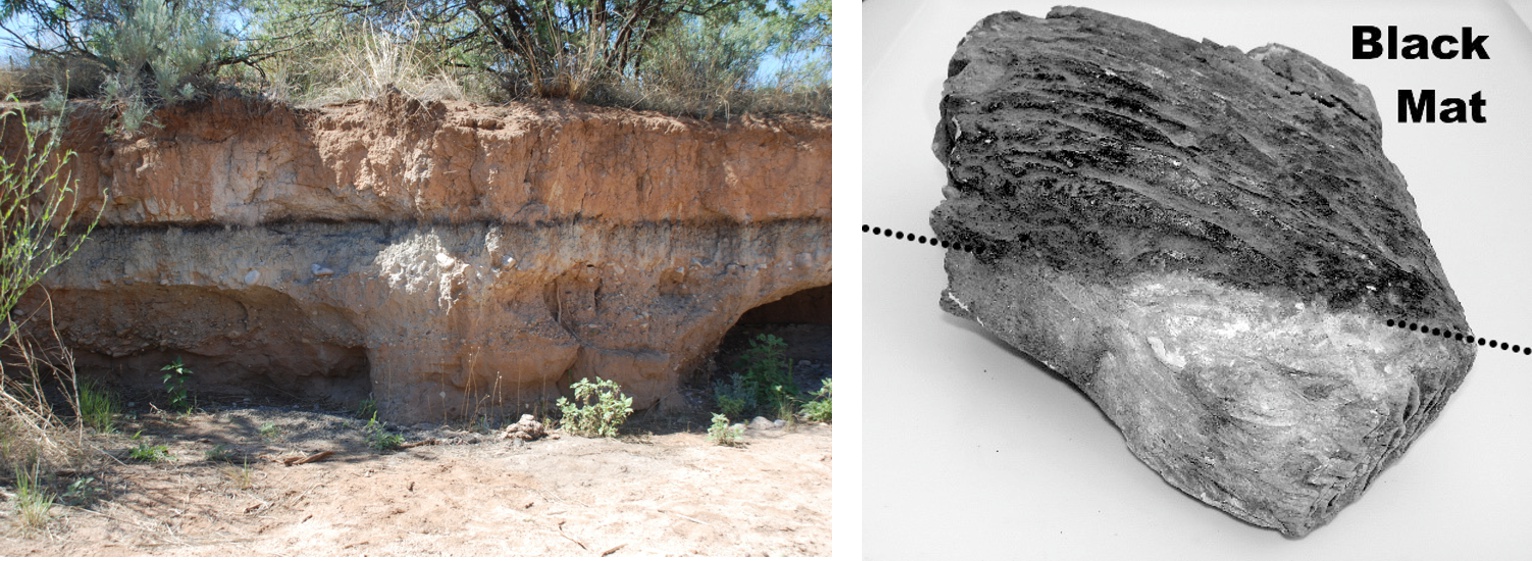
Vance Haynes has discussed the unusual "Big Eloise” mammoth find at Murray Springs: “Her bones were arranged in a lifelike pose with her head stretched out upright on the ground, just as she had fallen 13,000 years ago” (Fig. 2). Broken spear points, scrapers, knives, and other hunting tools were found beside her. Both her back legs were cut off, one lying next to her and the other a short distance away near a fire pit. A broken spear straightening tool was found nearby lying in a mammoth footprint as if it had been trampled by Eloise before her demise. The black mat was draped over Eloise and the other objects at the site. Clearly the butchering of Eloise was suddenly halted by the sudden catastrophic event that must have produced the black mat.
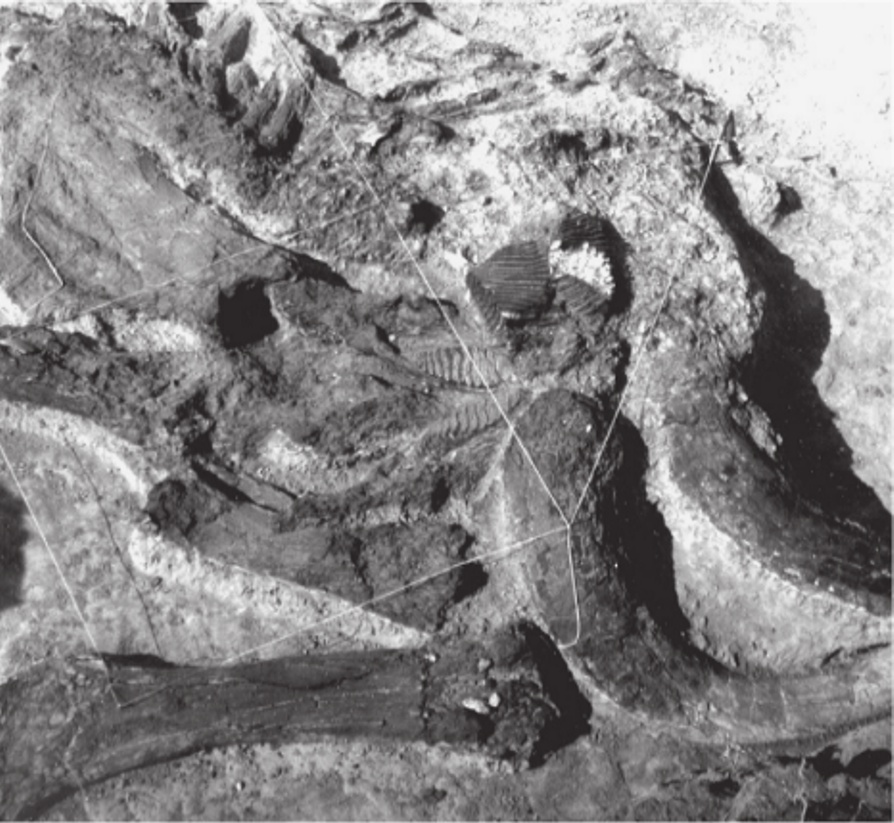
The widespread occurrence of a black mat 12,800 years ago, above which no megafauna fossils are found, is compelling evidence that the megafauna disappeared suddenly in a catastrophic event.
Magnetic particles and microspherules
A magnet placed directly below the black mat at Murray Springs and other sites will attract many magnetic particles not found in quantity further below or above the black mat. Microscopic analysis of these particles reveals many are spherical, some are dumbbell shaped, others are bottle shaped, hollow, or contain accretions or microcratering by smaller spherules (Fig. 3) .
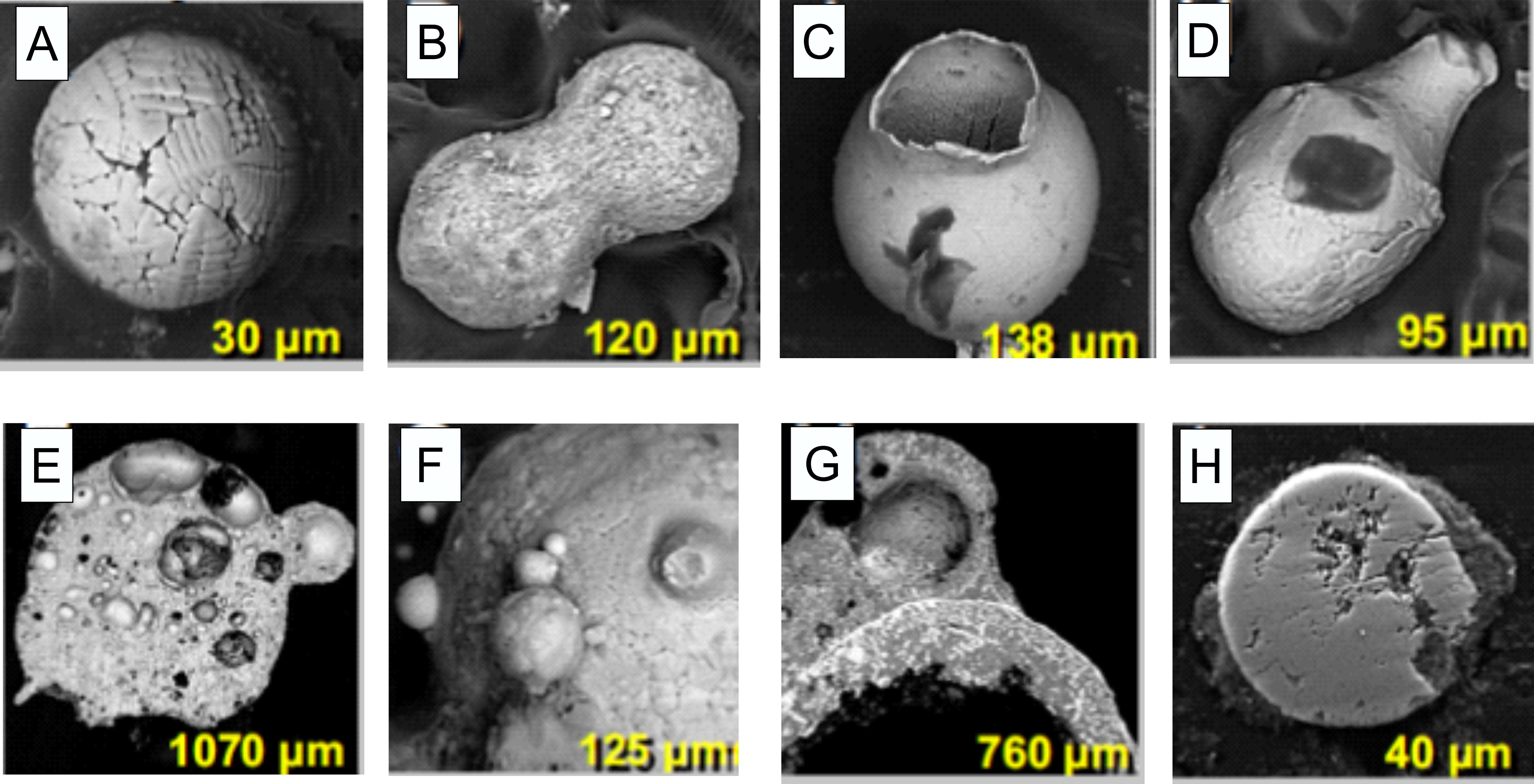
A few microspherules had shear marks that would have formed at >2,200°C. It appears that these microspherules emerged from a cloud of molten iron droplets, colliding with each other as they cascaded to Earth. The microspherules are geochemically and morphologically comparable with cosmic impact material from Meteor Crater, Arizona, and with material from the Trinity nuclear airburst in Socorro, New Mexico, and inconsistent with anthropogenic, volcanic, and authigenic materials . Similar evidence has been observed at 18 widely separated sites . This magnetic layer is also found at YD sites where no black mat is present and on the surface YD megafaunal fossils.
Platinum group elements
The PGE elements Os, Ir, Ru, Rh, Pt, Pd are rare in Earth’s crust but abundant in meteorites. Iridium, for example, was found at the Cretaceous–Paleogene (K-Pg) boundary indicating that the disappearance of the dinosaurs was linked to a meteorite impact. Similarly, a high concentration of Pt is found in the YDB at 26 sites including the Greenland ice core where the deposition is dated at 12,825 ± 20 cal yr BP . In addition, Ir and Os anomalies have also been found in the Greenland ice core . PGE elements are compelling evidence that the onset of the YD is associated with a meteor impact.
Widespread fire
Beneath the black mat and at all YDB sites is found charcoal, vesicular carbon spherules, glassy carbon, aciniform carbon (AC/soot), and nanodiamonds (Fig. 4) which are all evidence of associated burning.

While some of these burn markers could indicate localized fire, AC/soot and nanodiamonds have only been associated with meteorite impacts. The evidence for widespread biomass burning is not limited to YDB geoarcheological sites but extends to an even broader study of lake and marine cores across four continents where a simultaneous peak in burning is seen at the onset of the YD . Profound evidence of widespread burning at the onset of the YD is also seen in the Greenland ice cores where a massive peak in ammonium (NH4), a marker biomass burning, is observed at 12,822 ± 1 cal yr BP . Other markers including nitrate, oxalate, acetate, and formate, indicate that this was the largest biomass burning episode in at least 120,000 years. CO2 evidence from Antarctic ice cores suggests that fires may have consumed ≈ 9% of Earth’s biomass.
Population decline and extinction
At the onset of the Younger Dryas there was a massive, worldwide extinction of mammals weighing over 40 kg. It is estimated that 82% of these animals disappeared in North America, 74% in South America, 71% in Australasia, 59% in Europe, 52% in Asia, and 16% in Sub-Saharan Africa. Fossil evidence suggest the disappearances were very sudden. In addition to the extinction of the mammoths and the disappearance of horses in North America other species, including bison, deer, and moose suffered massive population losses (Fig. 5).

Conversely, human population in North America increased dramatically following the Younger Dryas. Clovis people hunted mammoths and other megafauna for only a short time before that prey disappeared. Waters and Stafford estimated that the Clovis time lasted as little as 200 years . However, their method of laying out the measured dates in order of value, irrespective of uncertainty, is invalid. A better method is simply weighted average of the data. This yields an average radiocarbon ages of 10,955 ± 27 yr and 10,970 ± 14 yr for North American and South America Clovis sites, respectively. These ages correspond to a calendar date ranging from 12,887-12,827 cal yr BP after correction for the difference in the radiocarbon and ice core scales . The Clovis era lasted only ≈ 60 years in the Americas and ended at the onset of the YD. The short period of time that Clovis people hunted mammoth is insufficient to have had significant effect on their extinction although humans may indeed have slaughtered the last remaining stragglers.
The Younger Dryas Impact
The nature of the object that caused the YD impact has not yet been experimentally determined. William Napier has proposed that the impact may have come from the debris field of a large 50–100 km comet that broke up in the inner solar system . Radio and visual data have identified a zodiacal cloud of largely cometary material including the remnants of Comet Encke. Napier hypothesized that terrestrial catastrophes may happen on timescales of approximately 0.1–1 Myr, due to the Earth running through swarms of debris from disintegrating large comets. This provides a plausible mechanism for the YD impact although direct association with this source is not proven.
The lack of a recognized crater has long been a criticism of the YD Impact. The orientation of the Carolina Bays points to an impact near the Great Lakes, but that explanation remains controversial. The widespread geographical evidence for the YD Impact suggests that there may have been multiple impacts from the breakup of a large, poorly consolidated comet striking various locations, as described by Napier. Recently a 31 km wide crater has been found beneath Hiawatha Glacier in Greenland dating to the late Pleistocene (Fig. 6). The authors imply that this impact is consistent with the onset of the YD.

Significant evidence of a YDB layer in Greenland was previously reported by several authors . From the crater size we can estimate that an energy of ≈ 2.4 x 106 megatons of TNT (mT) was released by the impact assuming either a 2.6 km diameter comet traveling at 50 km/s or a 4.2 km asteroid traveling at 15 km/s assuming the impact were into rock . An ice impact would require a meteorite ≈ 2 times as large. In either case the blast from this impact would devastate an area up to 1,300 km from the impact although the crater is so remote that the devastation area cannot directly explain the YD fires or the disappearance of megafauna. The average global thickness of the dust layer formed by the impact would be ≈4 mg/cm3, ≈ 200 times larger than the observed microspherules density . This dust would lead to a sudden global cooling, worldwide drought, and failure of photosynthesis, for an extended period of time . Substantial NOx and SO2 would be produced by this impact, enough to destroy Earth’s ozone layer exposing all life to increased ultraviolet radiation and increased acid rain . The impact that caused Hiawatha crater must have left a strong signature in the GISP2 climate record yet the only evidence in GISP2 of an impact coincides with the onset of the YD. There is no plausible reason why an impact leaving a 31 km crater wouldn’t have had a major global impact and leave its mark in the geological record.
The Eltanin impact, south of Chile in the Pacific Ocean, is comparable to the Hiawatha Crater. It’s crater is estimated at ≈ 35 km in diameter and the impact produced a thin melt rock layer enriched in iridium. The Eltanin impact occurred 2.51 ± 0.06 million years ago coincident with the end of the Pliocene era. It produced a 200 m high tsunami at the coast of Chile that was still 35 m high at the coast of Tasmania. The Eltanin impact pushed the Earth into an ice age with a mass extinction of 36% of all genera occurred including 55% of all marine mammals, 35% of sea birds, 43% of sea turtles, and 9% of sharks . This suggests that an impact at Hiawatha Crater could cause similar worldwide climate change and extinctions. All previous epochs appear to be correlated with the dates of meteor impacts leaving craters comparable to Hiawatha Crater as shown in Figure 7. No craters are observed in the ocean and few have been found in ice suggesting that the true impact rate is ≈ 4 times the rate inferred from terrestrial craters. It is apparent that these events are important triggers to climate change, extinctions, and evolution.
The bigger picture: regular impacts of comet debris
The Younger Dryas impact is also supported theoretically by astrophysical observations that show that Earth is regularly interacting with the debris of massive dead comets. Historically it is shown that Earth impacts are correlated with major geological changes such as occurred with the Eltanin impact, that involved an object comparable in size to the Hiawatha Crater impactor and caused an extinction rate comparable to that at the YD at the end of the Pliocene epoch. The YD impact coincides with the end of the Pleistocene epoch. While impacts as large as the K-Pg event that killed the dinosaurs are rare, there are certainly many smaller impacts that devastate localized regions yet go unrecognized. Such impacts likely occurred in Beringia ≈ 32-42 ka ago producing massive muck deposits containing the intermixed smashed remains of megafauna fossils and trees, micrometeorites embedded in fossils , microspherules and PGE elements in the sediments , and likely causing the disappearance of a major mammoth mitochondrial lineage . The YD impact is not only supported by extensive physical evidence, but also expected from a long history of cosmic impacts (Fig. 7).
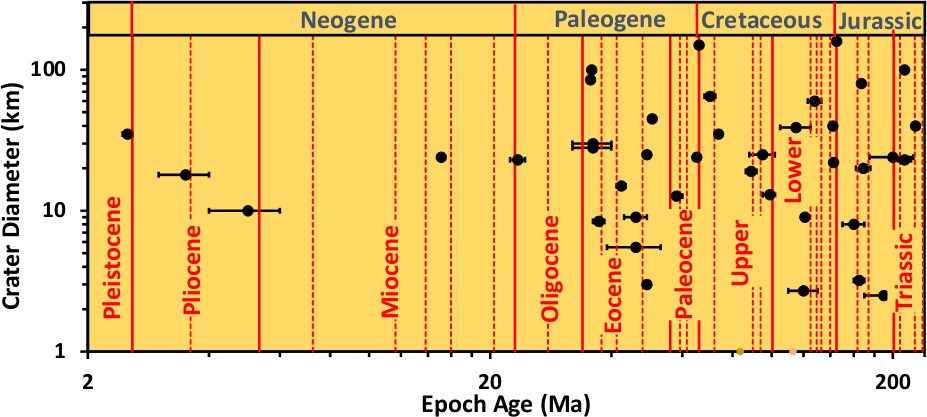
The Younger Dryas impact should no longer be viewed as a hypothesis but instead as an observation. The black mat provides a distinct dividing line, dated to the onset of the YD, at numerous sites above which no evidence of megafauna exists. Directly beneath the black mat is a thin deposit of impact markers including microspherules, nanodiamonds, PGE elements, and AC/soot. These impact markers can be found adhering directly to the fossil bones of megafauna. Widespread fires occured near the onset of the YD, and the products of intense burning peak simultaneously with the 18O/16O ratio signature of sudden YD cooling in the Greenland ice core. Clovis hunting stops abruptly as the YD commences. This scenario is self-consistent and abundantly supported by experimental data from over 22 sites (Fig. 8).
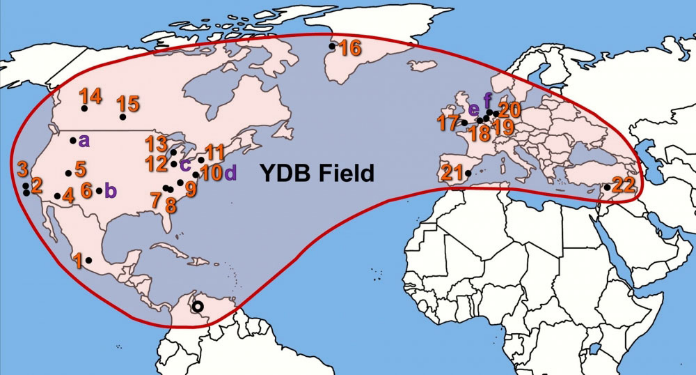
The evidence for the YD impact is compelling but continues to receive widespread criticism from a small number of purists. Attempts by reviewers to suppress the publication of the data have generally failed, and arguments against the data-based conclusions are largely anecdotal. In many respects the arguments against the YD impact have followed similar lines of criticism applied to continental drift, the impact origin of craters on the moon, and K-Pg impact that killed the dinosaurs. In each case “experts” refused to change preconceived notions despite the accumulated evidence. Perhaps the YD Impact can receive quicker acceptance since it is a harbinger of future catastrophic events that we expect to occur.
Responses